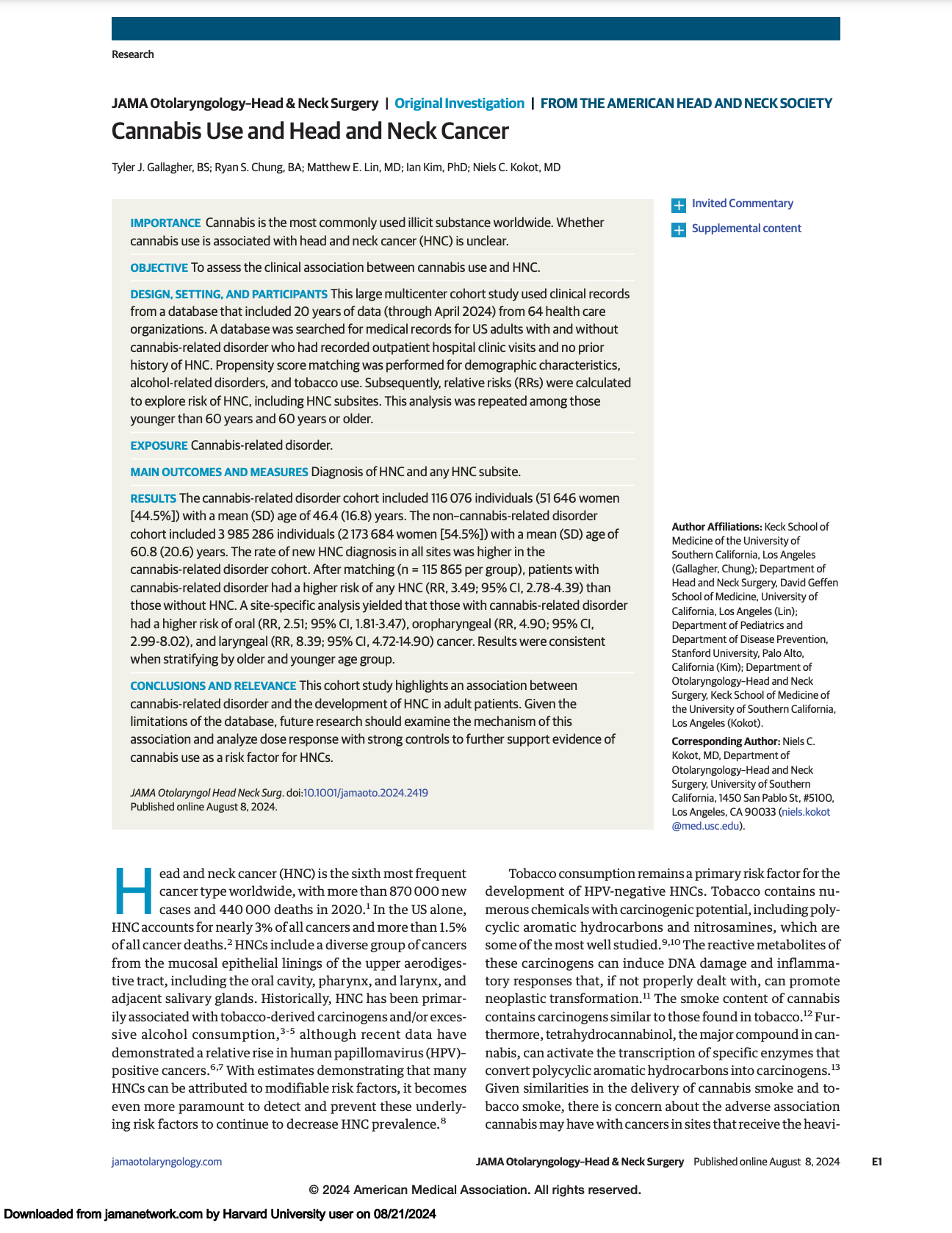Untangling the Headlines: A Critical Look at the Study Linking Cannabis to Cancer
Why One Study Doesn’t Make Cannabis the New Tobacco
Introduction
Recent headlines have swept through mainstream media, proclaiming a significant link between cannabis use and an increased risk of head and neck cancers. These findings, drawn from a new study published in JAMA by Tyler J. Gallagher, BS1; Ryan S. Chung, BA1; Matthew E. Lin, MD2; et al, have been widely circulated without much scrutiny, leading to widespread concern. However, a closer examination reveals that the study’s conclusions may not be as solid as they appear. The numerous limitations and potential biases inherent in the study suggest that we should be cautious about accepting these findings at face value.
For Full text, click here:
Here are the bold, bottom line claims made by this study:
Cannabis Use Linked to Higher Cancer Risk: The study suggests a significant connection between cannabis use and an increased risk of developing certain head and neck cancers, particularly laryngeal and oropharyngeal cancers.
Cannabis as a Possible Cause of Cancer: The study implies that cannabis use might directly lead to the development of these cancers, hinting at a cause-and-effect relationship.
Increased Cancer Risk for Cannabis Users: According to the study, people who use cannabis, especially those diagnosed with cannabis-related disorders, have a higher risk of developing these cancers compared to non-users.
Cannabis Compared to Other Carcinogens: The study suggests that the cancer risks associated with cannabis might be comparable to those linked to other known carcinogens like tobacco and alcohol.
Potential Public Health Concerns: The study raises concerns about the broader public health implications, suggesting that these findings might warrant stricter regulations or caution around cannabis use to prevent potential increases in cancer cases.
Medical research is essential for advancing our understanding of health and guiding us toward better treatments and prevention strategies. Researchers work hard to ensure their findings are solid and contribute to the bigger picture of what we know about health. But it’s also important to remember that no single study tells the whole story, especially when it comes to complex issues. Analyzing data and making it comparable across different studies is tough— it involves a lot of careful work, assumptions, and sometimes indirect estimates. Scientific progress happens gradually, by building on many studies and perspectives. With that in mind, let’s take a closer look at the recent study linking cannabis use to cancer, and see how it fits into the broader landscape of research and what might get overlooked in the headlines.
Science, and the publication of results, is a fragile and evolving process, not the sweeping, dramatic revelations that headlines often suggest. The reality is that human health and diseases are incredibly complex, and clear-cut answers or dramatic epiphanies (take, for example, OMG - cannabis causes head and neck cancers) are rare, if not unheard of. Most scientific discoveries shine light on just a small, specific aspect of a much bigger picture. All findings published by a small handful of scientists need to be viewed with careful consideration and skepticism, as they often come rich with the hopes/wishes and biases of the team conducting the work , and most often, the work reflects a unique situation that might not apply universally. The strength of science comes from its ability to question, adapt, and continually refine our understanding, rather than offering final, absolute answers.
Scratch The Record, Please: Let’s Peel Away the Smoke & Mirrors
It's important to take a magnifying glass to the findings of any study, and certainly one that suggests a significant link between cannabis use and an increased risk of any relatively common disorder. While this study “adds to the conversation,” the numerous limitations it contains should make us cautious about how much we trust its conclusions.
Read Between the Lines and The Twists of Academic Demonization
Many in modern culture have been brought up to see cannabis as evil. Some were made to believe it was a stepping stone to terrible things, others may have had a lousy experience themselves and simply swore it off as all bad, all the time. A study reporting a significant association between cannabis-related disorders and certain head and neck cancers, such as laryngeal and oropharyngeal cancers, is all too juicy a morsel of meat for both the researchers and the publishers at JAMA to let go of, no matter how much the tasty superficials may hide a little rot inside. But, there are enough critical issues with the study's design and how the data were interpreted for an astute reader to raise serious questions about the reliability of these findings and their leaps to conclusions. There’s enough here to raise polite, academic red flags. Hopefully shedding bright light on the failures will be enough to calm the exaggerated reports and unwarranted conclusions!
The Issue of Reverse Causality
A major concern is reverse causality—the possibility that people who are developing or already have undiagnosed cancers might be using cannabis to manage symptoms like pain or discomfort. The study doesn't adequately account for this, which means it can't reliably tell us whether cannabis use is a cause or simply a response to these cancers that had existed before the person decided to consume some cannabis.
Moreover, our bodies naturally produce cancerous cells as part of normal processes (read this post all about the 5000 cancers we produce every single day - gulp!) , and our immune system typically works to eliminate them before they become a problem (this is the whole point of having T-cells in our body). The endocannabinoid system, which helps regulate our immune function and maintain balance in our cells, could be involved in cases where this natural defense fails. Those who are prone to cancer might turn to cannabis for relief, leading to a misleading association between cannabis use and cancer when cannabis isn't actually the cause. Ironically, as the world slowly begins to discover that there are many elements of cannabis that appear to kill and prevent the growth of cancers, more than it having mere usefulness in treating symptoms, associations like the ones found in this study are likely to become more popular. (Murphy’s law, isn’t it?)
Missing Mechanism of Action
Another major flaw in the study is that it doesn't propose a clear mechanism of action—a plausible biological explanation for how cannabis could cause these cancers. Even though there ARE studies and literature on the mechanisms of action by which cannabis can stop cancer growth (see here), somehow the importance of postulating HOW this stuff actually works is a blatant omission here. In medical research, understanding how something works is key to proving that it actually does. Without this, the association the study found remains speculative - a wink and a hope. The endocannabinoid system, which plays a crucial role in maintaining cellular health, doesn't naturally suggest a pathway leading to cancer. In fact, some research shows cannabinoids might even help protect against certain cancers by promoting the death of cancerous cells. This lack of a clear mechanism suggests that the association might be due more to reverse causality than cannabis being a direct cause of cancer.
Flaws in the Study's Design and Interpretation
Several other flaws in the study's design and how the data were interpreted further weaken its conclusions:
No Control for Reverse Causality: The study doesn't account for the possibility that people might be using cannabis in response to early cancer symptoms, rather than cannabis causing the cancer.
No Dose-Response Analysis: The study doesn't tell us if the risk increases with more cannabis use, which is crucial for determining if cannabis is actually causing the cancer.
Detection Bias: People who use cannabis, especially those diagnosed with a cannabis-related disorder, might be more closely monitored by doctors, leading to higher rates of cancer detection. This could falsely inflate the association between cannabis use and cancer.
Ignoring Pre-Existing Conditions: Many cannabis users may have other health conditions that make them more likely to develop cancer. The study doesn't fully consider these factors, which means the association it found could be due to these other health issues, not cannabis use.
Coding as a Source of Participant Identifiers
In the context of building a study population for this article, the researchers rely on ICD-10 codes as a way to pick participants, and this presents a huge limitation. These codes are inherently subjective and often do not reflect the nuances of a patient’s cannabis use. Physicians documenting cannabis use are constrained by the limited options available to them in their electronic chart system, which are typically focused on diagnosing problems or disorders, and not merely adding interesting commentary about a patient’s choices, preferences, or personal liberties they take when dealing with medical challenges. This can easily lead to an inaccurate representation of someone’s cannabis consumption, where cannabis is marked as a problem even if it is not causing any harm to the patient, or in fact may be there to help the patient improve. Furthermore, these codes fail to capture essential details such as the amount, potency, or duration of cannabis consumption—factors that are crucial for assessing its true impact on health. As a result, these diagnoses can linger in a patient’s medical chart for years, potentially without proper context, which in the case of the current study, would powerfully skew the study’s findings. The presence of these codes, without an accurate and detailed record of cannabis use, may contribute to misleading associations between cannabis and cancer, undermining the study’s conclusions.
Unspoken Issues and Contradictions
The study also misses several important factors that could significantly change how we interpret its findings:
Changing Social and Legal Context: As cannabis becomes more accepted and legalized, the profile of cannabis users and the associated health risks might change, something this study doesn't consider. Where products are not legal and regulated, it’s easy for confounding variables to slip into studies unaccounted for.
Polydrug Use: The interaction between cannabis and other substances, like tobacco and alcohol, could affect cancer risk. The study doesn't thoroughly explore this, which is a big oversight.
Genetic and Environmental Factors: Differences in genetics and environmental exposures, which can significantly impact cancer risk, aren't accounted for in the study. This limits how applicable the findings are to different groups of people.
Putting Relative Risk in Perspective
Another important point is understanding the difference between relative risk and absolute risk. The study talks about an increased relative risk of cancer among cannabis users, but it’s important to translate that into real-world terms.
Relative Risk: This compares the risk between two groups (e.g., cannabis users vs. non-users). Even a high relative risk doesn’t necessarily mean the absolute risk is high.
Absolute Risk: This is the actual chance of developing a disease. For example, if the baseline risk of developing a certain cancer is 0.1% and cannabis use increases this by 3.5 times, the new absolute risk is still only 0.35%—a small increase in real terms.
In context, while the study reports an increased relative risk, the absolute risk of developing these cancers remains low for most people, especially those who use cannabis infrequently or for medical reasons.
Relative Risk, In Real Terms:
In the study, the relative risk of developing certain head and neck cancers among cannabis users might be reported as a multiple—say, 3.5 times higher than in non-users. To put this in perspective, imagine you're walking through a neighborhood where typically, 1 out of 1,000 homes experiences a small kitchen fire each year. If you suddenly decide to cook more often, and your relative risk of a kitchen fire increases 3.5 times, it now means you have a 3.5 out of 1,000 chance—still quite small. The difference feels more significant when expressed as "3.5 times higher," but in absolute terms, your risk has only increased by a tiny margin, much like the way the study's relative risk might sound alarming, but the actual increase in absolute risk could be very modest.
Absolute Risk, In Real Terms:
When you suspect a broken bone, getting an X-ray is a common first step in confirming the diagnosis, and most people wouldn’t think twice about it. While it’s true that an X-ray exposes you to a small amount of ionizing radiation—around 0.1 millisieverts, compared to the 3 millisieverts you receive from natural background radiation each year—the absolute risk increase of developing cancer from a single X-ray is minuscule, approximately 1 in 1,000,000. This risk is so small that it hardly registers in our everyday decision-making, especially when weighed against the immediate need to accurately diagnose and treat a potential injury. Similarly, flying in an airplane also exposes you to slightly higher levels of cosmic radiation due to the higher altitude. For instance, a typical long-haul flight might add around 0.05 millisieverts of radiation exposure—another small fraction of your annual background radiation dose. Yet, just like with X-rays, this increase is so minimal that it’s not something people typically worry about, particularly given the necessity and convenience of air travel.
For another example, consider the use of low-dose aspirin, which until very recently (until 2021-2022) was commonly recommended to reduce the risk of heart attacks and strokes in adults. While taking aspirin daily does slightly increase the risk of gastrointestinal bleeding—about 2 additional cases per 1,000 people over 5 years, or a 0.2% absolute risk increase—most doctors didn’t hesitate to prescribe it, and most people felt comfortable taking it. The small increase in bleeding risk is generally outweighed by the significant benefit of preventing life-threatening cardiovascular events. These examples show how minor risks are often accepted in the face of clear and substantial health benefits, reminding us that not all risk increases are cause for alarm.
A Table of Other Meaningful Limitations of This Study
Keep reading with a 7-day free trial
Subscribe to Doctor-Approved Cannabis to keep reading this post and get 7 days of free access to the full post archives.












